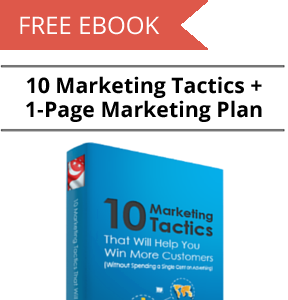.jpg?width=1200&name=4-Proven-Strat%20(1).jpg)
Some days, your job feels like a waste of time.
“Are these people actually going to take up the offer?!”
“If they’re not interested, they might as well say no right now instead of keeping me guessing!”
You meet new prospects, review your calls, have regular meet-ups with like-minded friends, yet you still don’t reach your target at the end of the quarter. And it doesn’t help when you see all of your friends celebrating their business breakthrough.
You’re happy for them (and slightly envious), mostly because you’re tired of not knowing the loophole in your sales process.
Really, what is it that you’re not seeing?
First of all, you need to understand the difference between B2C buyers and B2B buyers. Put yourselves in their shoes:
When you buy a consumer product, you're technically only accountable to your loved ones and yourself.
But when you're entrusted to buy a product on behalf of your employer, you're making a decision that can impact:

Therefore, there is a huge emphasis on company needs and your professional reputation at stake too (let’s be real). In fact, the decision-making process has various characteristics and factors that require more than one individual signing off.
In addition to that, there are typically 3 types of buying situations in a B2B setting:
|
New task – the firm is purchasing something for the first time. Modified rebuy – This happens when a firm repurchases an item that has been bought before with requests for specific modifications. Straight rebuy – the firm purchases some items on a routine basis. |
Needless to say, the biggest challenge happens in the new task situation. There is an entire B2B buying process that your prospect has to go through. If you want to help them see your product as the ideal solution, you’ll need to know who your organizational buyers are. Here are 4 B2B sales strategies to help you secure a qualified client.
1. Firstly, know (or test) your entry point.
Most of the time, B2B sales depends on where you introduce yourself into the prospect company. The first step here is to clearly identify who is the best person you should first approach.
-
What’s their title?
-
Who is your product built for?
-
Whose problem does it solve?
The answer to the above questions may be a manager that you should approach (or their immediate higher-up if any). Keep your sales pipeline full by having a well-calculated prediction about your ideal entry point and focus on that person at every prospect organization.
Remember not to aim too low as they may not have authority, or too high as they may not be relevant (or ready) to have that conversation. Sell at the highest relevant level - they will be the ones who lend you their ears and attention.
Here’s a tip from Craig Rosenberg about Marketo.
“Marketo is the hero of B2B Martech stack, but they are rarely engaging with the CMO early in the process. They sell to the Director of Demand Gen and the Director of Marketing Ops. Everything they do pivot around that person”
2. Observe the major players in the follow-up sales meeting.
Once you’ve stepped foot into the company, it’s time to pay attention to patterns that don’t show up in your marketing data.
As you connect with your prospect, you’ll get real-time qualitative insights about the company that’ll help you to determine what to do next.
-
Which title holders get called into the meeting room?
-
What level of influence does each member of the process have?
-
What criteria does each person use to evaluate prospective suppliers?
-
Who stands in the way of your pitch?
-
Why can’t they make a decision yet (who is absent)?
-
Which level does your deal usually get ‘stuck’?
-
What interpersonal and psychological factors influence this buying process?
-
How well do the individuals work together as a group?
-
Who makes the final decision to buy?
As you ask more questions, you’ll sometimes realize that you were wrong about the entry point. Perhaps someone else is more suitable to hear first-hand information about your solution. In some cases, there may be more than one entry point - and that’s how you move along.
All these discoveries are gems to help you cultivate a smarter entry point the next round.
3. Keep reviewing your sales script.
Can you use your template scripted approach to engage different entry points?
Not all the time. But what should you change? What questions should you ask? You need to keep in mind that you should not attempt to close the deal at the entry point. You’ll most likely be talking to the stepping stone that’ll introduce you to the person who’ll approve the purchase.
See how the process is much more complicated than B2C?
You need to listen, listen, listen. You need to empathise with their challenges.
You need to hold your assumptions loosely and build your own data on your prospects’ internal challenges. You’ll be surprised at how the purchasing power has changed in comparison to the past.
4. Bring all your findings back to your marketing team.
If this isn’t practised in your company, it should be.
You see, every organization is unique, and the answers you get from listening to their problems will help you to understand the buying behaviours influencing B2B sales. These insights will enable your marketing team to identify the similarities within your target segment so that:
-
You can build (or relook at) your buyer personas together
-
You can collectively create effective marketing materials to address the challenges, goals, and interest that your capture your prospects’ attention at different levels
Think about this: As a salesperson, do you find your current marketing materials useful for you?
If you find it cliche or off the mark - you need to have a proper (and respectful) discussion with your marketing team.
All the marketing efforts that your team is working on should serve your prospects at the awareness, consideration and decision stage.
At this point, you’ll probably realize the need for a different whitepaper, Q&A, articles, tutorials, and ads that would help your client to make a confident purchase decision.
And guess what - you’re absolutely right.
All these different content should serve to qualify your prospects and guide them through their buying journey.
Does the best script exist to close more B2B sales?
It doesn’t. However, the best tool for you to approach your prospect is through empathy. With the experience that you have, build solid buyers personas so that you can face each entry point or department and say:
"Hey, I know what's going on. Here are the X roadblocks you face every day. I have an idea on how you can fix them.”
Here’s a FREE buyers persona template for you to understand your organizational buyers better. Give us a call, we’ll be more than glad to guide you through them.


 hello@clicktrue.biz
hello@clicktrue.biz
 info.my@clicktrue.biz
info.my@clicktrue.biz info.th@clicktrue.biz
info.th@clicktrue.biz info.id@clicktrue.biz
info.id@clicktrue.biz info.vn@clicktrue.biz
info.vn@clicktrue.biz




